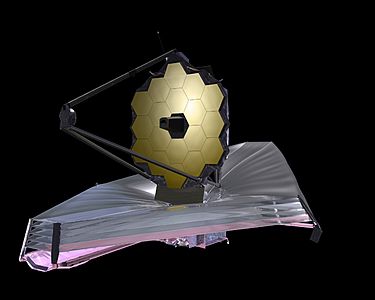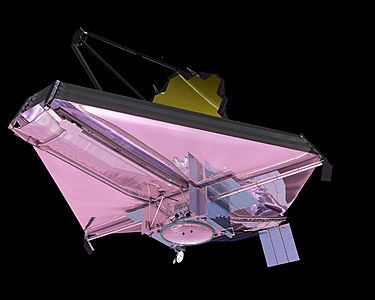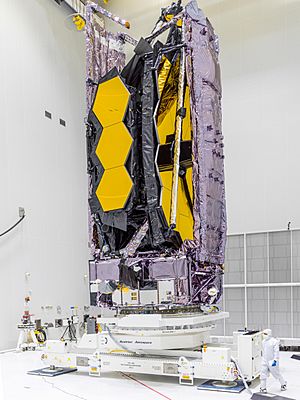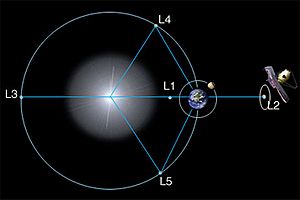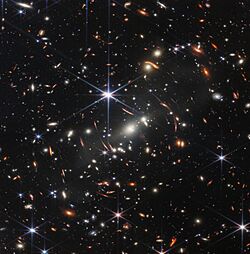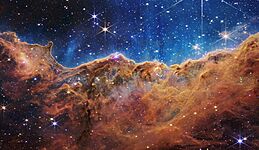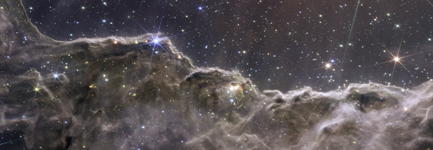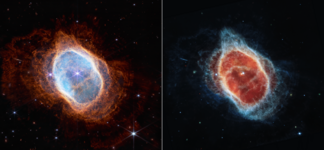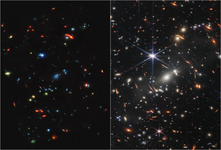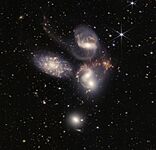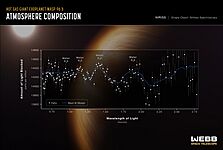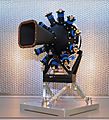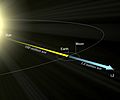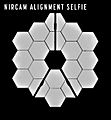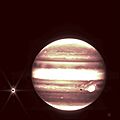James Webb Space Telescope facts for kids
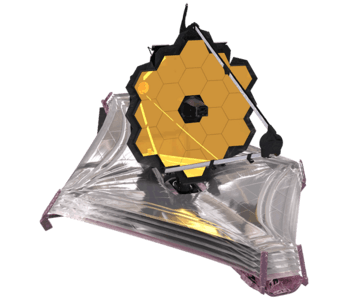
Rendering of the fully deployed James Webb Space Telescope
|
|
| Names | Next Generation Space Telescope (NGST; 1996–2002) |
|---|---|
| Mission type | Astronomy |
| Operator | STScI (NASA) / ESA / CSA |
| Website | |
| Mission duration |
|
| Spacecraft properties | |
| Manufacturer |
|
| Launch mass | 6,500 kg (14,300 lb) |
| Dimensions | 21.197 m × 14.162 m (69.54 ft × 46.46 ft), sunshield |
| Power | 2 kW |
| Start of mission | |
| Launch date | 25 December 2021, 12:20 UTC |
| Rocket | Ariane 5 ECA+ (S/N 5113, Flight VA256) |
| Launch site | Guiana, ELA-3 |
| Contractor | Arianespace |
| Entered service | 12 July 2022 |
| Orbital parameters | |
| Reference system | Sun–Earth L2 orbit |
| Regime | Halo orbit |
| Periapsis | 250,000 km (160,000 mi) |
| Apoapsis | 832,000 km (517,000 mi) |
| Period | 6 months |
| Main telescope | |
| Type | Korsch telescope |
| Diameter | 6.5 m (21 ft) |
| Focal length | 131.4 m (431 ft) |
| Focal ratio | f/20.2 |
| Collecting area | 25.4 m2 (273 sq ft) |
| Wavelengths | 0.6–28.5 μm (orange to mid-infrared) |
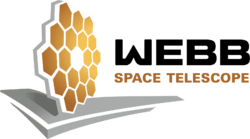 James Webb Space Telescope mission logo Large Strategic Science Missions
Astrophysics Division |
|
The James Webb Space Telescope (JWST) is a powerful space telescope. It is made to look at the universe using infrared astronomy. This means it sees heat and light that our eyes cannot. It is the largest telescope ever launched into space.
JWST has very clear and sensitive tools. This lets it see objects that are too old, far away, or dim for the Hubble Space Telescope. It helps scientists study many areas of astronomy and cosmology. For example, it looks for the first stars and how the first galaxies formed. It also studies the air around potentially habitable exoplanets.
The Webb telescope's main mirror is 2.7 times bigger than Hubble's. Even so, it takes pictures with similar sharpness. This is because it looks at longer infrared light waves. Longer waves need a bigger mirror to get clear images.
The Webb telescope was launched on December 25, 2021. It flew on an Ariane 5 rocket from Kourou, French Guiana. In January 2022, it reached its special orbit. This orbit is near the Sun–Earth L2 Lagrange point. It is about 1.5 million kilometers (930,000 miles) from Earth. The telescope's first amazing image was shown to the public on July 11, 2022.
The U.S. National Aeronautics and Space Administration (NASA) led the Webb's design. They worked with the European Space Agency (ESA) and the Canadian Space Agency (CSA). NASA's Goddard Space Flight Center managed building the telescope. The Space Telescope Science Institute in Baltimore runs the Webb telescope. The main company that built it was Northrop Grumman.
The telescope is named after James E. Webb. He was the head of NASA from 1961 to 1968. This was during the Mercury, Gemini, and Apollo space programs.
Webb's main mirror has 18 hexagon-shaped parts. These parts are made of gold-plated beryllium. Together, they form a 6.5-meter (21-foot) wide mirror. Hubble's mirror is 2.4 meters (7.9 feet) wide. This means Webb collects about six times more light than Hubble.
Hubble sees ultraviolet and visible light (0.1 to 2.5 micrometers). Webb sees a different range of light. It sees long-wavelength visible light (red) through mid-infrared (0.6 to 28.5 micrometers). The telescope must be kept super cold, below -223 degrees Celsius (-370 degrees Fahrenheit). This stops the telescope's own heat from messing with the light it collects. Its five-layer sunshield keeps it safe from the Sun, Earth, and Moon's warmth.
Plans for the telescope began in 1996. It was first called the Next Generation Space Telescope. It took a long time and a lot of money to build. Construction finished in 2016. After many years of testing, it cost about US$10 billion.
Contents
Amazing Features of Webb
The James Webb Space Telescope weighs about half as much as the Hubble Space Telescope. JWST has a 6.5-meter (21-foot) wide main mirror. This mirror is made of 18 separate hexagonal pieces. Each piece is coated with gold and made of beryllium.
The mirror's polished area is 26.3 square meters (283 square feet). A small part is blocked by supports. This gives it a total light-collecting area of 25.4 square meters (273 square feet). This is over six times larger than Hubble's mirror. Hubble's mirror is 2.4 meters (7.9 feet) wide and collects 4.0 square meters (43 square feet) of light. The gold coating helps it reflect infrared light. A thin layer of glass protects the gold.
JWST is mainly for near-infrared astronomy. But it can also see orange and red visible light. It can also see in the mid-infrared range. It can spot objects 100 times fainter than Hubble. It can also see objects much earlier in the universe's history. This goes back to about 180 million years after the Big Bang. For comparison, the earliest stars may have formed 100–180 million years after the Big Bang. The first galaxies might have formed around 270 million years after. Hubble cannot see further back than about 400 million years after the Big Bang.
Webb focuses on infrared light for several reasons:
- Very early and distant objects have their visible light stretched into infrared. So, we can only see them with infrared telescopes.
- Infrared light can pass through dust clouds more easily than visible light.
- Cold objects like debris disks and planets shine brightest in infrared.
- It is hard to study these infrared light bands from Earth. Existing space telescopes like Hubble also cannot study them well.
Telescopes on Earth must look through our atmosphere. The atmosphere blocks many infrared light bands. Even where it is clear, chemicals like water and carbon dioxide in our air make it hard to study space. Existing space telescopes like Hubble cannot study these bands well. This is because their mirrors are not cold enough. Hubble's mirror is about 15 degrees Celsius (59 degrees Fahrenheit). So, the telescope itself gives off too much infrared light.
JWST can also look at nearby objects. This includes things in our Solar System. It can see planets, moons, comets, and asteroids beyond Earth's orbit. It can also quickly observe sudden events. These include supernovae (exploding stars) and gamma-ray bursts.
Where Webb Orbits
The JWST orbits far from Earth. This helps it avoid heat coming from the Earth and Moon. This special orbit is beyond the Moon. It is at the second Lagrange point (L2) of the Sun-Earth system. This is a place where gravity is stable. This orbit is 1.5 million kilometers (930,000 miles) from Earth. That is about four times farther away than the Moon.
This orbit keeps Webb in Earth's shadow most of the time. It does not actually go around the Earth. Instead, it goes around the Sun at the same speed as the Earth.
What Webb Hopes to Discover
The James Webb Space Telescope has four main goals:
- To find light from the first stars and galaxies. These formed in the universe after the Big Bang.
- To study how galaxies form and change.
- To understand how stars and planets form.
- To study planetary systems and the beginnings of life.
These goals are best met by looking at near-infrared light. This is why JWST's tools do not measure visible or ultraviolet light like Hubble. Instead, they are much better at infrared astronomy. JWST can see light from orange colors to deep infrared radiation.
JWST might gather information on the dimming light of star KIC 8462852. This star was found in 2015 and has strange light changes.
Also, it can tell if a planet outside our solar system has methane in its air. This helps astronomers figure out if methane could be a sign of life.
How Webb is Supported and Operated
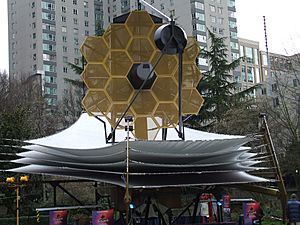
The Space Telescope Science Institute (STScI) in Baltimore, Maryland, runs JWST's science and operations. They are in charge of how the telescope is used for science. They also deliver the data to astronomers.
Data from JWST is sent to Earth using the NASA Deep Space Network. It is then processed at STScI. After that, it is shared online with astronomers around the world. Anyone can suggest ideas for what Webb should observe. Each year, scientists review these ideas. They choose which projects Webb will work on. The scientists who suggested the chosen projects get to see the new data first. After one year, the data becomes public. Anyone can download it from STScI's online archive.
The telescope can send about 458 gigabits of data each day. This is like a constant speed of 5.42 megabits per second. Most of the data processing on the telescope is done by computers. A special chip called SIDECAR ASIC helps turn the instrument's data into digital form. This chip is very small (3 cm) and uses little power (11 milliwatts). This low power use is key to keeping the telescope cold.
Webb Compared to Other Telescopes
Scientists have wanted a large infrared space telescope for many years. Space telescopes are great because they do not have Earth's atmosphere blocking infrared light. This opened up a "new sky" for astronomers.
However, infrared telescopes have a challenge. They need to stay extremely cold. The longer the infrared light wave, the colder they must be. If not, the telescope's own heat would blind its sensors. This problem can be solved by using a special container with a super cold substance, like liquid helium. But this coolant slowly runs out, limiting the telescope's life to a few months or years.
Some telescopes can stay cold enough without a constant supply of coolant. They use special designs like sunshields and radiators. Webb uses these methods. Its mid-infrared instrument also has an extra cooler.
| Name | Launch Year | Wavelength (micrometers) |
Mirror Size (meters) |
Cooling Method |
|---|---|---|---|---|
| Spacelab Infrared Telescope (IRT) | 1985 | 1.7–118 | 0.15 | Helium |
| Infrared Space Observatory (ISO) | 1995 | 2.5–240 | 0.60 | Helium |
| Hubble Space Telescope Imaging Spectrograph (STIS) | 1997 | 0.115–1.03 | 2.4 | Passive (no special coolant) |
| Hubble Near Infrared Camera and Multi-Object Spectrometer (NICMOS) | 1997 | 0.8–2.4 | 2.4 | Nitrogen, later cryocooler |
| Spitzer Space Telescope | 2003 | 3–180 | 0.85 | Helium |
| Hubble Wide Field Camera 3 (WFC3) | 2009 | 0.2–1.7 | 2.4 | Passive, and thermo-electric |
| Herschel Space Observatory | 2009 | 55–672 | 3.5 | Helium |
| James Webb Space Telescope | 2021 | 0.6–28.5 | 6.5 | Passive, and cryocooler (for MIRI) |
Webb's delays and cost increases are similar to those of its older cousin, the Hubble Space Telescope. Hubble was estimated to cost US$300 million in 1972. But by its launch in 1990, it cost about four times more. New tools and repair missions also added to its cost.
Amazing Discoveries and Images
JWST finished its setup and began full science work on July 11, 2022. Most experiment data is kept private for one year for the scientists who requested it. Then, the raw data is released to the public.
Webb's observations have greatly improved our understanding of planets outside our solar system. They also help us learn about the first billion years of the universe.
First Full-Color Images
The first full-color images and data were released on July 12, 2022. This also marked the start of Webb's general science work. U.S. President Joe Biden showed the first image, Webb's First Deep Field, on July 11, 2022. Other images released around this time include:
- Carina Nebula – a young, star-forming area called NGC 3324. It is about 8,500 light-years from Earth. NASA called it "Cosmic Cliffs."
- WASP-96b – an analysis of the air around a giant gas planet. This planet orbits a distant star 1120 light-years away. It showed signs of water.
- Southern Ring Nebula – clouds of gas and dust from a dying star. It is 2,500 light-years from Earth.
- Stephan's Quintet – a group of five galaxies. Their gas and dust clouds are crashing together, making new stars. Four central galaxies are 290 million light-years from Earth.
- SMACS J0723.3-7327 – a galaxy cluster. Distant galaxies behind it look stretched and bigger because of the cluster's gravity. This image was called Webb's First Deep Field. Later, three ancient galaxies were found in this picture. They existed soon after the Big Bang. These images show the universe as it was 13.1 billion years ago.
On July 14, 2022, NASA showed infrared images of Jupiter and its surroundings from JWST.
Scientists from NASA, ESA, and CSA said that "the science performance of JWST is better than expected." They noted that during setup, the instruments took very precise measurements of planets passing in front of their stars. They also tracked fast-moving objects. Webb also got images of hundreds of stars at once in a dense area near the Milky Way's center.
Other things Webb observed include:
- Moving objects: Jupiter's rings and moons (like Europa), and several asteroids.
- A Jupiter-sized planet called HAT-P-14b.
- A clear view of a very small companion star, AB Doradus C. This was the first time this method was used in space.
- A hot super-Earth planet called L 168-9 b orbiting a bright red dwarf star.
Bright Early Galaxies
Within two weeks of the first Webb images, scientists found many very bright galaxies. These galaxies are believed to be from 235 million to 280 million years after the Big Bang. This is much earlier than thought possible before. On August 17, 2022, NASA released a huge image made of 690 smaller pictures. It showed many very early galaxies. Some early galaxies seen by Webb, like CEERS-93316, are thought to be from 235.8 million years after the Big Bang.
In May 2024, JWST found the most distant known galaxy, JADES-GS-z14-0. It was seen just 290 million years after the Big Bang. This galaxy is much brighter and bigger than expected for such an early time. This discovery challenges what we know about how early galaxies formed.
Gallery
- First images by the James Webb Space Telescope – released 12 July 2022
-
Cosmic Cliffs of Carina Nebula (NGC 3324) (NIRCam)
-
Carina Nebula (NGC 3324) (MIRI)
-
Webb's First Deep Field (SMACS 0723; Left: MIRI; Right: NIRCam)
-
Stephan's Quintet (NIRCam/MIRI composite)
Images for kids
-
Alternative Hubble Space Telescope views of the Carina Nebula, comparing ultraviolet and visible (top) and infrared (bottom) astronomy. Far more stars are visible in the latter.
-
JWST as seen from the ESC-D Cryotechnic upper stage shortly after separation, approximately 29 minutes after launch. Part of the Earth with the Gulf of Aden is visible in the background of the image.
-
Segment alignment begins by defocusing the segment images by moving the secondary mirror slightly. Mathematical analysis, called phase retrieval, is applied to the defocused images to determine the precise positioning errors of the segments. Adjustments of the segments then result in 18 well-corrected "telescopes". However, the segments still do not work together as a single mirror.
-
Image stacking. To put all of the light in a single place, each segment image must be stacked on top of one another. In the image stacking step, the individual segment images are moved so that they fall precisely at the center of the field to produce one unified image. This process prepares the telescope for coarse phasing.
-
Image comparison between "old" Spitzer and new JWST
See also
 In Spanish: Telescopio espacial James Webb para niños
In Spanish: Telescopio espacial James Webb para niños


